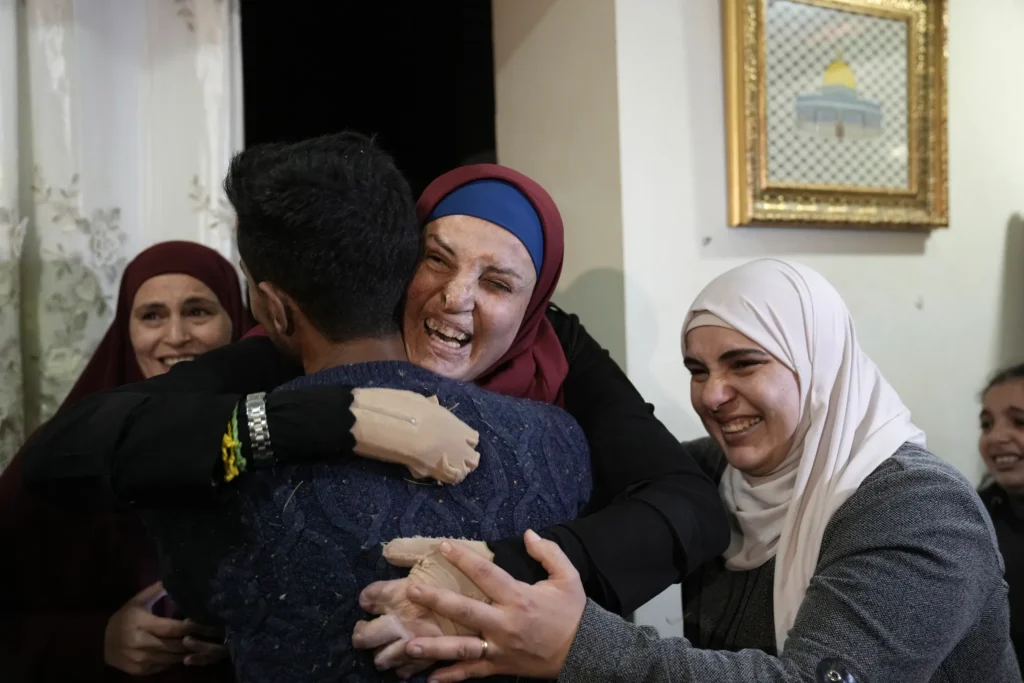ISRAEL-GAZA WAR
In Gaza Strip’s Deir al-Balah, the delicate truce between Israel and Hamas showed signs of stabilization on Sunday. Hamas released 17 hostages, including 14 Israelis and the first American, marking the third exchange during a four-day cease-fire, with hopes of an extension, as expressed by the U.S. Simultaneously, Israel freed 39 Palestinian prisoners, all young men.

Gaza Strip’s
Some hostages were directly handed over to Israel, while others exited through Egypt. Notably, an elderly woman was airlifted to a hospital, requiring immediate medical assistance, according to U.S. President Joe Biden. The emotional moment of freedom was celebrated by hundreds of Israelis at an air force base, as the hostages, waving flags, arrived.
The age range of the released hostages was vast, spanning from 4 to 84, including Abigail Edan, a 4-year-old dual citizen who tragically lost her parents in the initial Hamas attack on Oct. 7. President Biden, acknowledging the unimaginable ordeal she endured, emphasized the goal of extending the cease-fire for as long as possible.
Israeli Prime Minister Benjamin Netanyahu’s office disclosed that the list included nine children aged 17 and younger, along with three additional Thai nationals. In a separate release, Hamas mentioned the liberation of a Russian hostage, attributed to the efforts of Russian President Vladimir Putin. Notably, the Russian-Israeli citizen was the first male hostage to regain freedom.
A fourth exchange is anticipated on Monday, the concluding day of the cease-fire, during which a total of 50 hostages and 150 Palestinian prisoners are slated for release. The majority of the released individuals are women and minors, viewed by many Palestinians as heroes resisting occupation.
“We can get all hostages back home. We have to keep pushing,” stated two of Edan’s relatives, expressing gratitude to the mediators.
International mediators, led by the U.S., Egypt, and Qatar, are actively working to extend the cease-fire initiated on Friday.
For the first time, Hamas expressed its intention to prolong the deal by focusing on releasing a larger number of hostages. Rear Adm. Daniel Hagari, the Israeli army’s chief spokesman, stated openness to extending the cease-fire if more hostages are freed. Israel had previously outlined that the truce could be extended by an extra day for every additional 10 hostages released, emphasizing, however, a swift resumption of the offensive once it concludes.
Netanyahu, ahead of the recent release, visited the Gaza Strip, engaging with troops and affirming the commitment to the return of every hostage. He declared an unwavering determination to continue until victory, though his exact location within Gaza remained unclear.
This marks the first significant pause in the seven-week war, characterized by the deadliest Israeli-Palestinian violence in decades. According to the Health Ministry in Hamas-ruled Gaza, over 13,300 Palestinians, predominantly women and minors, have lost their lives. The conflict has claimed the lives of more than 1,200 Israelis, primarily civilians impacted by the initial attack.
Life in Captivity
Families in the southern Israeli town of Kfar Aza expressed a mix of emotions on Sunday as they welcomed the news of hostages from their town arriving in Israel. The Kibbutz, home to around 700 people, experienced over 70 casualties and 18 kidnappings.
The freed hostages have mostly remained out of the public eye. Hospitals report their overall good physical condition, yet little is publicly known about the details of their captivity.
Merav Raviv, whose three relatives were released on Friday, shared insights into their ordeal. Irregular feeding and weight loss were common, with one reporting a diet mainly consisting of bread and rice. Makeshift beds of chairs pushed together and extended waits for bathroom use added to the challenges faced by the hostages.
The pressure from families has intensified the dilemma facing Israel’s leaders, torn between the goal of eliminating Hamas as a military and governing power and the humanitarian aspect of the hostages’ plight. During the incursion into southern Israel that triggered the war, Hamas and other fighter groups seized approximately 240 individuals. Of these, 58 have been released, one freed by Israeli forces, and two found dead inside Gaza.
Hamas Commander Killed
Hamas reported the death of Ahmed al-Ghandour, in charge of northern Gaza and a member of its top military council. He is the highest-ranking fighter confirmed to have been killed in the conflict, a confirmation echoed by Israel’s military.
Al-Ghandour had survived at least three Israeli attempts on his life and played a role in a cross-border attack in 2006, during which Palestinian fighters captured an Israeli soldier. According to the Counter Extremism Project, a Washington-based advocacy group, he had been involved in multiple activities.
Hamas stated that he was killed alongside three other senior fighters, including Ayman Siam, alleged by Israel to be in charge of Hamas’ rocket-firing
unit. The Israeli military had previously mentioned both men in a statement on Nov. 16, stating that it had targeted an underground complex where Hamas leaders were hiding.
The Israeli military claims to have successfully eliminated thousands of fighters, although concrete evidence to support these claims has not been provided.
Meanwhile, the conflict has led to a surge in violence in the Israeli-occupied West Bank. Palestinian health authorities reported on Sunday that five Palestinians were killed in an Israeli military raid in the West Bank city of Jenin that began the day before. The overall toll of the war in the West Bank has now reached 239.
The Israeli army has been conducting frequent raids and arresting hundreds of Palestinians since the war’s onset, primarily targeting individuals suspected of being members of Hamas.
Aid to Northern Gaza
The temporary pause in hostilities has brought some relief to Gaza’s 2.3 million residents, who are still grappling with the aftermath of relentless Israeli bombardment that displaced three-quarters of the population and leveled residential areas. During this lull, rocket fire from Gaza fighters into Israel has ceased.
War-weary Palestinians in northern Gaza, the primary focus of the offensive, cautiously returned to the streets. However, entire city blocks in and around Gaza City bear the scars of extensive airstrikes.
Yet, those among the hundreds of thousands of Palestinians who fled the north have encountered obstacles when attempting to return and check on their homes. Israeli troops have reportedly opened fire on anyone approaching from the south, as stated by Rami Hazarein, a Gaza City resident.
The Israeli military has issued orders for Palestinians not to return to the north or approach within a kilometer (around a half-mile) of the border fence. In a tragic incident, the Palestinian Red Crescent rescue service reported that Israeli forces opened fire on two farmers in central Gaza on Sunday, resulting in one death and another person being wounded. An Israeli military spokesperson stated they were not aware of the incident.
The United Nations acknowledges that the temporary truce has allowed for an increase in the delivery of essential supplies, such as food, water, and medicine, marking the largest volume since the war’s commencement. However, it underscores that the current amount of 160 to 200 trucks per day is hardly sufficient.
For the first time since the war began, fuel has been delivered, reaching areas in the north that had been inaccessible for a month. Additionally, the Palestinian Red Crescent Society reported that 50 aid trucks from Egypt crossed through checkpoints to reach Gaza City and northern areas on Sunday.
